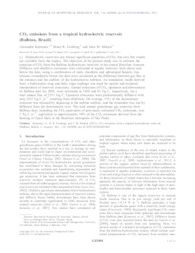CO2 emissions from a tropical hydroelectric reservoir (Balbina, Brazil).
CO2 emissions from a tropical hydroelectric reservoir (Balbina, Brazil).
Author(s): KEMENES, A.; FORSBERG, B. R.; MELACK, J. M.
Summary: Hydroelectric reservoirs can release significant quantities of CO2, but very few results are available from the tropics. The objective of the present study was to estimate the emission of CO2 from the Balbina hydroelectric reservoir in the central Brazilian Amazon. Diffusive and ebullitive emissions were estimated at regular intervals, both above and below the dam, using a combination of static chambers and submerged funnels. Gas releases immediately below the dam were calculated as the difference between gas flux at the entrance and the outflow of the hydroelectric turbines. An inundation model derived from a bathymetric map and daily stage readings was used for spatial and temporal interpolation of reservoir emissions. Annual emissions of CO2, upstream and downstream of Balbina dam for 2005, were estimated as 2450 and 81 Gg C, respectively, for a total annual flux of 2531 Gg C. Upstream emissions were predominantly diffusive with only 0.02 Gg C yr-1 resulting from ebullition. On average, 51% of the downstream emission was released by degassing at the turbine outflow, and the remainder was lost by diffusion from the downstream river. The total annual greenhouse gas emission from Balbina dam, including the CO2 equivalent of previously estimated CH4 emissions, was 3 Tg C yr-1, equivalent to approximately 50% of the CO2 emissions derived from the burning of fossil fuels in the Brazilian metropolis of São Paulo.
Publication year: 2011
Types of publication: Journal article
Unit: Embrapa Mid-North
Keywords: CO2, Emissão de gás carbônico
Observation
Some of Embrapa's publications are published as ePub files. To read them, use or download one of the following free software options to your computer or mobile device. Android: Google Play Books; IOS: iBooks; Windows and Linux: Calibre.
Access other publications
Access the Agricultural Research Database (BDPA) to consult Embrapa's full library collection and records.
Visit Embrapa Bookstore to purchase books and other publications sold by Embrapa.

